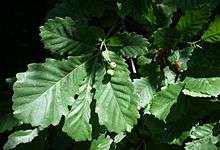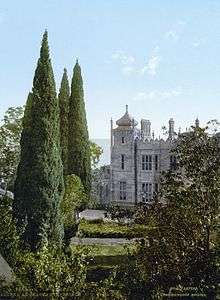Nicolai Anders von Hartwiss
Nicolai Anhorn von Hartwiss (Николай Андерс фон, де Гартвис, Николай Андреевич; was a Livonian-born, Baltic German, Russian botanist, plant explorer and plant breeder. His education at the university in Tartu was interrupted by the Napoleonic Wars 1812–1818 when he served in the Russian army. Afterwards he worked on his father's estate and by 1824 was living in Riga and had a collection of 500 varieties of fruit trees and roses. He was then appointed to the Russian Imperial Botanical Garden at Nikita where he served as a director for the rest of his career. He is remembered for his plant collection explorations of Georgia and the Crimea, and for the breeding of roses.
Nicolai Anhorn von Hartwiss | |
|---|---|
| Born | Nikolaus Ernst Bartholomäus Anhorn von Hartwiss 24 May 1793 Kokenhof, Livonia |
| Died | 6 December 1860 Artek, Crimea |
| Nationality | Russian |
| Education | University of Dorpat (= Tartu) |
| Occupation | botanist and plant breeder |
| Employer | Nikita Imperial Botanic Garden, Yalta, Crimea |
| Title | Director of the Botanic Garden |
| Term | 1827–1860 |
| Predecessor | H.H. Steven |
| Spouse(s) | Elizabeth Feodorovna Baroness von Rosen |
| Parent(s) | Heinrich Ernst Anhorn von Hartwiss of Livonia and Christiane Anhorn von Hartwiss (his first cousin) |
Life
Von Hartwiss was born (Ritter) Nikolaus Ernst Bartholomäus Anhorn von Hartwiss, Hartwiß in 1793 at his father's estate at Kokenhof near Wolmar, Livonia (now Valmiera, Latvia).[1] The family Anhorn von Hartwiss (double name) comes from Switzerland. His grandfather Silvester Samuel (1708–1782) descended from Swiss Protestant pastors and emigrated to Russia. His father, Heinrich Ernst was a registered member of the Livonian nobility (reg. 1769). He married his first cousin Christina Louisa. Nikolaus was their tenth child.[2][3] By that time Livonia (roughly present day Latvia and the southern part of Estonia) had been absorbed (under the Governorate of Livonia) into the Russian Empire, but the nobility still retained its ancient Baltic German forms and spoke Low German.[4][5]
Nikolaus was educated at German-speaking Dorpat (now Tartu) university (1809-1812), where his studies were interrupted by Napoleon.[2][3][6]
He was an officer of the Russian Army in the Napoleonic Wars 1812–1818, discharged with wounds.[2] This implies that he was (and remained) a subject of the Tsar, not in any sense a Russian citizen.[6]
Von Hartwiss at one time gained practical gardening experience laying out fields of flowers, fruit trees and both exotic and domestic trees on his father's estate.[2] In 1819–1824 he lived in Riga, gardening and fruit growing, with a collection of 500 varieties of fruit trees and roses.[3]
In 1824 he was appointed by Mikhail Semyonovich Vorontsov, governor-general of New Russia, to the Russian Imperial Botanical Garden at Nikita in Yalta on the south coast of the Crimea. In 1827 he became its second director, which he remained until he died. He extended the Garden's collection of plant varieties from more than a thousand to about three thousand, including the largest collection of fruit varieties in Europe.[3]
From Nikita he organised plant hunting expeditions into the surrounding territories, especially the Crimea and Abkhazia in the Caucasus.[2][3]
He and his first wife, Elizabeth Feodorovna Baroness von Rosen, had a 500-acre estate[7] called Artek near Bear Mountain (Ayu-Dag) in the Crimea.[8] After the death of his first wife in 1855 he married a young girl from Riga in Simferopol on 2 Feb. 1858, Leontine Werther, who died at the end of the same year giving birth to a daughter.[3][9]
Exploration

Von Hartwiss collected plants in Georgia and the Crimea. Some species were named by him, some named after him.[2] "Three long expeditions [were made] to the Caucasus in search of new ornamental plants for the Crimea … Caucasian fir, spruce, … Caucasian basswood, rhododendrons, azaleas and other flowering shrubs."[3]
Eponyms
- (Boraginaceae) Cordia hartwissiana Regel[10]
- (Cupressaceae) Juniperus hartwissiana Steven ex Koeppen[11]
- Strandzha oak[12] (Fagaceae) Quercus hartwissiana Steven[13][14]
- (Paeoniaceae) Paeonia hartwissiana Hort. ex Trautv.[15]
Plant breeding

Von Hartwiss imported many plants for the Botanic Garden, including roses. In 1827 he began to breed roses. These were partly for the Garden itself, but also for the Alupka Palace of Count (later Prince) Michael Vorontsov. Some thirty of his roses were sold from the Alupka Palace nursery.[2][17]
Roses bred
Von Hartwiss bred more than 100 varieties of roses at the Nikita Garden.[2] Two are still growing at the Alupka Palace: 'Comtesse Elizabeth Woronzof' 1829 and 'Belle de Nikita' 1829. There may also be his rose 'Mignonette d'Alupka' 1829, thought by some to be the rose imported into France and sold as 'Maréchal Niel'.[8][18] Hartwiss's hand-written 1834 catalogue of roses at Nikita lists scores of roses bred there identified only by description.[17] The Crimean Rose Society – including roses bred after 1834 – lists 127 named varieties.[19]
Sortable selection of Hartwiss-bred roses[17][20][21]
| Name | Date | Type | Colour | Extant |
|---|---|---|---|---|
| Baronne Julie de Berkheim[22] | <1834 | China hybrid | unknown | Lost |
| Belle Lila | <1834 | Gallica | unknown | Lost |
| Belle de Livonie[23] | 1827 | Alba hybrid | unknown | Lost |
| Belle de Nikita[24] | 1829 | China hybrid | Pink | Yes |
| Belle de Riga[25] | <1834 | Gallica hybrid | unknown | Lost |
| Blanche de Riga[26] | <1834 | Alba hybrid | White | Lost |
| Bouquet de Nikita[27] | 1829 | Sempervirens hybrid | unknown | Lost |
| Comtesse Elizabeth Woronzof[28] | 1829 | China hybrid | Chamois with pink | Yes |
| Comtesse Nathalie Tchernischoff[29] | <1834 | semperflorens hybrid | unknown | Lost |
| Comtesse Pahlen | <1834 | semperflorens hybrid | unknown | Lost |
| Foncée-brillante de Livonie[30] | <1834 | Gallica hybrid | unknown | Lost |
| Incomparable de Livonie[31] | <1834 | Gallica hybrid | unknown | Lost |
| Mignonette d'Alupka[32] | 1829 | Hybrid Noisette | Cream | Yes |
| Ombrée de Riga[33] | <1834 | Gallica hybrid | unknown | Lost |
| Princesse Anne Golitzin[34] | <1834 | Grevilliae hybrid | Rich red | Lost |
| Prometheus | <1834 | Gallica hybrid | unknown | Lost |
| Violacea | <1834 | China-semperflorens hybrid | unknown | Lost |
| Woldemar Hagen | <1834 | Gallica hybrid | unknown | Lost |
References
- Galichenko, Anna Abramovna (2001). "The Correspondence of N. Hartwiss with M.S. Vorontsov". Nobility in the history of the Russian state: Proceedings of the third Vorontsov lectures (in Russian). Simferopol. Retrieved 25 April 2012.
- Galichenko, Anna Abramovna (2001). "Nicholas Hartwiss and the rose collection of the Imperial Botanic Garden at Nikita". Bulletin of the State Botanic Garden Nikita (in Russian). Yalta. 83. Retrieved 25 April 2012.
- Klimenko, Zinaida Konstantinovna; et al. (2006). "Nikolai Andreyevich Hartwiss, second director of the Nikita Botanic Garden". Bulletin of the Nikita State Botanic Garden (in Russian). Yalta. 92. Retrieved 25 April 2012.
- Christiansen, Eric (1997). The Northern Crusades (New ed.). London: Penguin. p. 92. ISBN 0140266534.
- Davies, Norman (2011). Vanished kingdoms : the history of half-forgotten Europe. London: Allen Lane. ISBN 978-1-846-14338-0. Especially the chapter "Litva".
- Anderson, Benedict (1996). Imagined communities : reflections on the origin and spread of nationalism (Rev. ed., 7. impr. ed.). London [u.a.]: Verso. p. 87. ISBN 0860915468.
- McFarquar, Neil (13 August 2015). "To Many in Crimea, Corruption Seems No Less at Home Under Russian Rule". New York Times. Retrieved 24 August 2015.
- Arbatskaya, Yu. and K. Vikhlyaeva (2011). "Rosa 'Alupka'. The detective on the botanical trail" (in Russian). Retrieved 25 April 2012. Cite journal requires
|journal=(help) - Arbatskaya, Yu. (2012). "Sad Ghost: the Hartwiss Park in Artek" (in Russian). Retrieved 25 April 2012. Cite journal requires
|journal=(help) - Gartenfl. (1857) 342. (IK)
- Ueb. Pfl. Acclimat. in Russl. 6. (IK)
- "Stranzhda Natural Park". Retrieved 30 April 2013.
- Bull. Soc. Imp. Naturalistes Moscou xxx. (1857) I. 387. (IK)
- "Quercus hartwissiana". Retrieved 30 April 2013.
- Trudy Imp. S.-Peterburgsk. Bot. Sada viii. (1883) 61, nomen. (IK)
- IPNI. Hartwiss.
- Galichenko, Anna Abramovna. "Inhaling the scent of Roses". World of Estate Culture. Eighth Crimean International Scientific Readings (in Russian). Retrieved 25 April 2012. No date.
- Arbatskaya, Yu. (c. 2011). "Old roses on the south coast of Crimea" (in Russian). Retrieved 25 April 2012. Cite journal requires
|journal=(help) - "Heritage Roses in Crimea (Ukraine)". Association Rose Amateurs of Crimea. Retrieved 10 January 2014.
- Klimenko, Zinaida Konstantinovna (2010). "Summary of Rose Breeding 1824–2010 in the Nikita Botanic Garden". Bulletin of the Nikita Botanic Garden (in Russian). 100: 49–55.
- HelpMeFind. "'Gartvis / Anhorn von Hartwiss, Nikolaj Andreevič (Nikolaus)' plant lists". helpmefind.com.
- HelpMeFind. "'Baronessa Julija Berkheim' Rose". helpmefind.com.
- HelpMeFind. "'Prekrasnaja Livonija' Rose". helpmefind.com.
- HelpMeFind. "'Prekrasnaja Nikita' Rose". helpmefind.com.
- HelpMeFind. "'Prekrasnaja Riga' Rose". helpmefind.com.
- "'Blanche de Riga'". Help Me Find. Retrieved 22 April 2013.
- HelpMeFind. "'Buket Nikity' Rose". helpmefind.com.
- HelpMeFind. "'Comtesse de Woronzoff' Rose". helpmefind.com.
- HelpMeFind. "'Comtesse Natalie Tchernischoff' Rose". helpmefind.com.
- HelpMeFind. "'Temno-brilliantovaja Livonija' Rose". helpmefind.com.
- HelpMeFind. "'Nesravnennaja Livonija' Rose". helpmefind.com.
- HelpMeFind. "'Alupka' Rose". helpmefind.com.
- HelpMeFind. "'Tenistaja Riga' Rose". helpmefind.com.
- HelpMeFind. "'Knjaginja Anna Galitsyna' Rose". helpmefind.com.
External links
- Help Me Find Roses entry on von Hartwiss
- (Russian and English) "Heritage Roses in Crimea (Ukraine)". Crimean Rose Society. Retrieved 10 January 2014.
